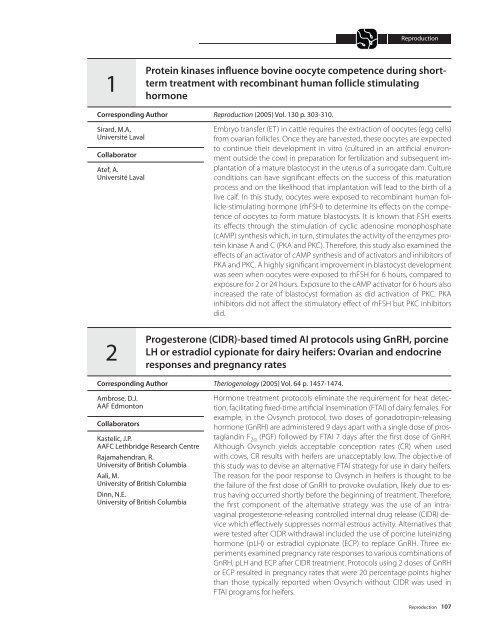A52-75-2007E.pdf - AgroMedia International Inc
A52-75-2007E.pdf - AgroMedia International Inc
A52-75-2007E.pdf - AgroMedia International Inc
Create successful ePaper yourself
Turn your PDF publications into a flip-book with our unique Google optimized e-Paper software.
Reproduction1Protein kinases influence bovine oocyte competence during shorttermtreatment with recombinant human follicle stimulatinghormoneCorresponding AuthorSirard, M.A.Université LavalCollaboratorAtef, A.Université LavalReproduction (2005) Vol. 130 p. 303-310.Embryo transfer (ET) in cattle requires the extraction of oocytes (egg cells)from ovarian follicles. Once they are harvested, these oocytes are expectedto continue their development in vitro (cultured in an artificial environmentoutside the cow) in preparation for fertilization and subsequent implantationof a mature blastocyst in the uterus of a surrogate dam. Cultureconditions can have significant effects on the success of this maturationprocess and on the likelihood that implantation will lead to the birth of alive calf. In this study, oocytes were exposed to recombinant human follicle-stimulatinghormone (rhFSH) to determine its effects on the competenceof oocytes to form mature blastocysts. It is known that FSH exertsits effects through the stimulation of cyclic adenosine monophosphate(cAMP) synthesis which, in turn, stimulates the activity of the enzymes proteinkinase A and C (PKA and PKC). Therefore, this study also examined theeffects of an activator of cAMP synthesis and of activators and inhibitors ofPKA and PKC. A highly significant improvement in blastocyst developmentwas seen when oocytes were exposed to rhFSH for 6 hours, compared toexposure for 2 or 24 hours. Exposure to the cAMP activator for 6 hours alsoincreased the rate of blastocyst formation as did activation of PKC. PKAinhibitors did not affect the stimulatory effect of rhFSH but PKC inhibitorsdid.2Progesterone (CIDR)-based timed AI protocols using GnRH, porcineLH or estradiol cypionate for dairy heifers: Ovarian and endocrineresponses and pregnancy ratesCorresponding AuthorAmbrose, D.J.AAF EdmontonCollaboratorsKastelic, J.P.AAFC Lethbridge Research CentreRajamahendran, R.University of British ColumbiaAali, M.University of British ColumbiaDinn, N.E.University of British ColumbiaTheriogenology (2005) Vol. 64 p. 1457-1474.Hormone treatment protocols eliminate the requirement for heat detection,facilitating fixed-time artificial insemination (FTAI) of dairy females. Forexample, in the Ovsynch protocol, two doses of gonadotropin-releasinghormone (GnRH) are administered 9 days apart with a single dose of prostaglandinF 2α (PGF) followed by FTAI 7 days after the first dose of GnRH.Although Ovsynch yields acceptable conception rates (CR) when usedwith cows, CR results with heifers are unacceptably low. The objective ofthis study was to devise an alternative FTAI strategy for use in dairy heifers.The reason for the poor response to Ovsynch in heifers is thought to bethe failure of the first dose of GnRH to provoke ovulation, likely due to estrushaving occurred shortly before the beginning of treatment. Therefore,the first component of the alternative strategy was the use of an intravaginalprogesterone-releasing controlled internal drug release (CIDR) devicewhich effectively suppresses normal estrous activity. Alternatives thatwere tested after CIDR withdrawal included the use of porcine luteinizinghormone (pLH) or estradiol cypionate (ECP) to replace GnRH. Three experimentsexamined pregnancy rate responses to various combinations ofGnRH, pLH and ECP after CIDR treatment. Protocols using 2 doses of GnRHor ECP resulted in pregnancy rates that were 20 percentage points higherthan those typically reported when Ovsynch without CIDR was used inFTAI programs for heifers.Reproduction 107





